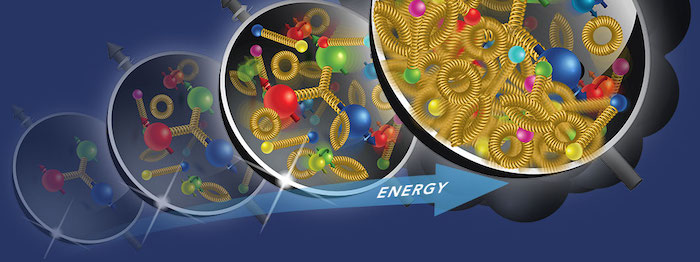KU to lead new program supporting inter-American research on nuclear science

LAWRENCE — Quarks and gluons are fundamental building blocks of all visible matter in the universe. They’re described by the theory of strong nuclear interactions: quantum chromodynamics, or QCD. But a complete grasp of how observed properties in the universe emerge from these interactions has remained elusive. Much as the understanding of atoms and their structure led to the development of very precise instruments such as atomic clocks, physicists think a better understanding of QCD will accelerate a host of breakthroughs in science and technology.
“Addressing open questions in quantum chromodynamics is a global effort, with large and ambitious international projects in the Americas, Europe and Asia,” said Daniel Tapia Takaki, associate professor of physics at the University of Kansas. “The U.S. will be home to a unique next-generation facility for QCD — the Electron-Ion Collider — and it has a strong participation in international projects such as the CERN Large Hadron Collider.”
Tapia Takaki is leading a new $250,000 project, dubbed the Accelerating Research through International Network-to-Network Collaborations (AccelNet) program, designed to speed scientific discovery and prepare the next generation of U.S. researchers for multiteam international collaborations. Funded jointly by the NSF AccelNet Program and the Established Program to Stimulate Competitive Research (EPSCoR), the new AccelNet project will support strategic links among U.S. and international research networks to leverage research and educational resources and tackle grand scientific challenges that require significant coordinated international effort.
“This design-track AccelNet project will focus on deeply fundamental questions like, ‘How did visible matter come into being, and how does it evolve? How does subatomic matter organize itself, and what phenomena emerge?’” Tapia Takaki said. “This project will focus on designing and establishing a ‘network of networks’ across the United States, Canada and Latin America to accelerate the process of tackling QCD challenges in nuclear physics. It will enable the training of students, postdoctoral researchers and early-career scientists in international multiteam nuclear physics projects that will have a strong participation of networks from this region.”
The KU researcher said these activities will promote integration of nuclear physics communities across the Americas and also serve to identify ethics norms and scientific guidelines for U.S.-led network-to-network projects in nuclear physics.
This AccelNet project will engage the domestic and international network partners around four main goals:
- develop strategic partnerships across the various nuclear physics research networks in the Americas
- identify needs, strengths and synergies of network partners for developing U.S.-led, large-scale nuclear science projects
- design activities for researchers in the U.S., Canada and Latin America that will facilitate leveraging complementary resources for quantum chromodynamics research
- enhance the training of the next generation of researchers in nuclear physics in a novel set of skills that include international multiteam experience.
Tapia Takaki will serve as the principal investigator, partnering with the following co- principal investigators: Carlos Bertulani from Texas A&M University-Commerce, Jean Delayen of Old Dominion University, Christine Aidala of the University of Michigan and Abhay Deshpande from Stony Brook University.
“We’re all very excited to design the Inter-American network of networks on QCD challenges,” Tapia Takaki said. “The design will be based on discussions and inputs from the nuclear physics community and the different network partners. It is also an honor for us at the University of Kansas to be leading the coordination of this new effort working closely with colleagues from various institutions, research centers and national laboratories.”
The new project is funded for two years starting from Sept. 1, 2021, and is expected to leverage additional resources to fully implement the program in coming years.
“To enable diverse network opportunities, the research themes will be broad, including research in theory, data analyses, high-performance computing, particle detectors and accelerator technologies, real-time event selection, as well as software and Monte Carlo simulation development,” Tapia Takaki said. “Applications of emerging technologies, such as artificial intelligence and quantum technologies, will also be part of the coordination effort. The activities will include scientific retreats, meetings, workshops and the development of a website to facilitate coordination. The project will also design and carry out exchange and mobility programs between networks in the U.S., Canada and Latin American countries.”
Photo: The image illustrates one of the QCD predictions physicists are interested in studying. As energy increases, protons are more likely to be formed of high-density gluon-saturated matter. This can help to answer other current challenges related to polarization features of nuclear targets. Credit: U.S. Department of Energy.